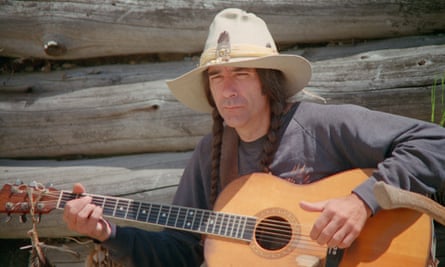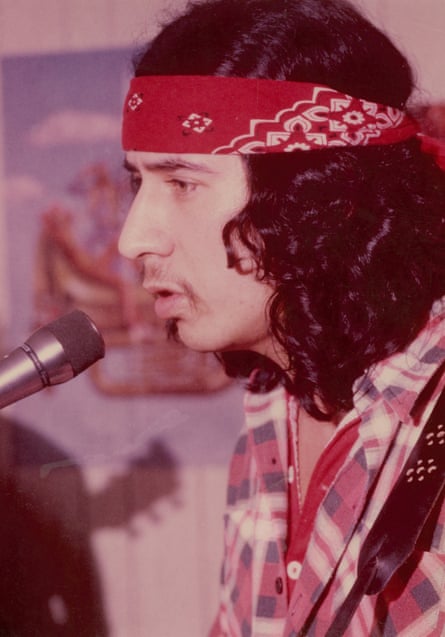On a Monday evening in August, I am sitting at a Holiday Inn in downtown Toronto with John Angaiak, a Yup’ik Inuit musician who has travelled more than 4,300 miles to get here. The bar is closing early; a glass of last-call red wine sits in front of him. As soon as we are introduced, he proudly shows me photos of his wife and daughter from his wallet and describes his life back in Homer, Alaska, in plain words that sound lifted from his own lyrics. “I live far away by the ocean,” he says. “I catch and eat fresh fish; I paint; I write songs. If you come visit, I’ll cook for you.”
Of the dozen or so performers arriving for the next day’s festival of indigenous Canadian music, Native North America Gathering, Angaiak has made the furthest trek, which is saying a lot for a group travelling from points north, west, and east to play on the same stage, some for the first time in decades, some for the first and likely only time ever.
The concert is part of the labour of love that yielded the 34-song Grammy-nominated compilation Native North America (Vol. I): Aboriginal Folk, Rock, and Country 1966-1985, released in 2014 by the US reissue label Light in the Attic. It features a generation of musicians whose songs are indelibly fused to the places their ancestors inhabited for years, whose once forgotten folk and protest music is undergoing a particularly timely revival; it was merely coincidence that a historic gathering of Native musicians would occur in the midst of the 150th anniversary of the Canadian confederation – the process by which the British colonies of Canada, Nova Scotia and New Brunswick were united into one dominion.
Kevin Howes, the Vancouver-based curator of the comp, spent a good decade tracking down the First Nations and Aboriginal makers of the records he had unearthed in basements and swap meets all over Canada. The pioneering singer and film-maker Willie Dunn was battling cancer when Howes found him at home in Ottawa. Morley Loon had died in 1986. Willie Thrasher was busking on the British Columbia waterfront, performing rousing rock’n’roll eco anthems for earth and water with his new singing partner, Linda Saddleback. Willy Mitchell had helped start a network of community radio stations on the Algonquin reserves in Ontario.
Signs celebrating Canada’s 150th anniversary still banner banks and storefronts when I arrive in Toronto, though many of the firework celebrations have come and gone. Visible too, are the remains of posters plastered on lampposts that decry the colonial overtones: “Canada 150 on Stolen Land!”, “Canada 150 is a Celebration of Land Theft”.
A line of ticketholders snakes around the block outside Trinity St Paul church before sunset. Inside, NNA’s first act, the Anishinaabe poet and self-described “wisdom-keeper” Duke Redbird takes the stage. When he says, “12,000 years ago, our ancestors left their moccasin imprints in the blue clay,” that much-heralded century-and-a-half flashes by in a tiny blip, gone nearly as fast as the CAN $500m (£311m) the government reportedly budgeted to commemorate it.
The NNA festival meanwhile has no corporate sponsor, working instead in tandem with the indigenous music network RPM.fm. Reunion tours tend to be booked out of financial necessity for ageing musicians who can’t survive on their back catalogues in the age of Spotify, or by promoters capitalising on nostalgia – last year’s Desert Trip (aka “Oldchella”) brought together Bob Dylan, Paul McCartney, the Rolling Stones, the Who, and the NNA artists’ compatriot Neil Young for two weekends that grossed $160m. But for a festival of musicians whose records were initially pressed in extremely limited numbers, who never made much money from their music in the first place, there is no need to market their songs back into relevance.

The early-70s ignited a Red Power movement in Canada, fuelled in part by the influx of Vietnam draft-dodgers who brought with them civil rights, women’s rights, and news of the 1973 Wounded Knee standoff (in which members of the American Indian Movement occupied a town in South Dakota).
The events that first prompted them to take up a guitar or drum include a gunshot fired into the back of Willy Mitchell’s head by the police, when he was 15, for allegedly stealing a Christmas light bulb; Canada’s residential school program that, until the mid-90s, removed First Nations kids from their families and stripped them of their first language and culture; Duke Redbird’s successful bid to require public schools to recite a daily acknowledgment of stolen lands; and Vern Cheechoo’s fight against a proposed mining project known as the Ring of Fire near his home in James Bay. In an age of police brutality, in which a notoriously high number of indigenous women are missing or have been murdered, and with climate change activists emboldened by the Standing Rock resistance, the times, it seems, have caught up with them.
Backstage, in a sacristy transformed into a green room, an easy camaraderie settles in – shared coffee and smokes, smudging sage before the show, warming up guitars, trading compliments (“John, your songs are so gentle,” Saddleback exudes to Angaiak). There is grey now in Eric Landry’s long braids; Redbird, who on stage rhymes “venom and disgrace” with “the human race,” is now 78. Pearl, the ivory Fender Telecaster Thinline that Willy Mitchell bought in his teens with the settlement money he received in the aftermath of his gunshot, has yellowed with age. Mitchell is dressed almost identically to the picture of his 1970s self projected on the screen behind him: plaid flannel shirt, bandana now wrapped around his wrist instead of his head. He cheerfully douses his arthritic knuckles with medicinal spray.

There is nostalgia for the early days and a clear affinity for the music of other outsiders. “We grew up playing dance music,” Leland Bell tells me after the show. Dance music? “You know, Creedence Clearwater Revival, Hank Williams.” Duke Redbird performed in coffeehouses with his then-neighbour Joni Mitchell. There are strains of John Fahey in Eric Landry’s haunting Loon Lake, and of Neil Young in songs by Mitchell (his fiery Kill’n Your Mind could sit with Revolution Blues) and Angaiak (Harvest Moon). Thrasher and Saddleback’s renegade anthem Wolves Don’t Live By the Rules begs for a punk-rock cover, and it’s not a stretch to picture the trio of Lloyd Cheechoo (once known as the Elvis of the North), his cousin Vern and Lawrence Martin making a killing in Nashville.
But truly, this is music that operates purely and insistently on its own terms. Songs by the Native North America artists are born partly from geographic isolation, unaccountable to the mainstream. When Angaiak sings lyrics like, “I’ve always been a poor man,” they read as starkly honest poems, with a sneaking, subtle acknowledgment that even the ordinary is not so (“You will begin to know the silent ocean is very rich, with its own life”).
The guiding spirit hovering over Native North America is that of the aforementioned Willie Dunn, who died of cancer just before the compilation’s release. His family has come from Ottawa for the concert, where Dunn’s haunting 1968 short film The Ballad of Crowfoot is screened. At 10 minutes long, it has been billed as one of the first ever music videos – the soundtrack is Dunn’s song of the same name, a stirring and sombre chronicle of the aboriginal story in Canada. Told through the figure of the Siksika First Nation chief, Crowfoot, in archival photographs, it builds to a furious torrent of headlines of broken treaties. The quiet in the room becomes even louder. Thrasher buries his face in his shirt. Dunn died four years ago this month and his absence is still raw. “The longer he’s gone the louder his words get,” Lawrence Dunn tells me later. “In fact, they become stifling.”
It’s a night no one wants to end but time is slipping fast before the church’s curfew. “Let’s stand for the mountains and the rivers and the trees!” Thrasher exhorts, when he and Saddleback finish out the night. He lets out a powwow cry as he pounds out a thunderous rhythm with his kick pedal; Saddleback takes up her tambourine. “We love the earth – let’s rock!”
Someone suggests setting up an impromptu afterparty in the grocery store parking lot across the street. Eventually, Thrasher, Saddleback, Mitchell, Landy and Bell lead a small procession down Bloor Street, and the musicians unpack their guitars on a street corner. “This reminds me of Willie,” Dunn’s widow Liz Moore says, sitting with Lawrence and her sister, Jackie. “Nights like this he’d sit out in the yard and play and people would just wander in off the street.” She nods in the direction of a couple of strangers, who have followed the sound here. The circle of listeners parted, opened, and let them in.

Comments (…)
Sign in or create your Guardian account to join the discussion